The flexibility of the plasterboard
VerifiedAdded on 2022/08/23
|10
|1738
|17
AI Summary
Contribute Materials
Your contribution can guide someone’s learning journey. Share your
documents today.
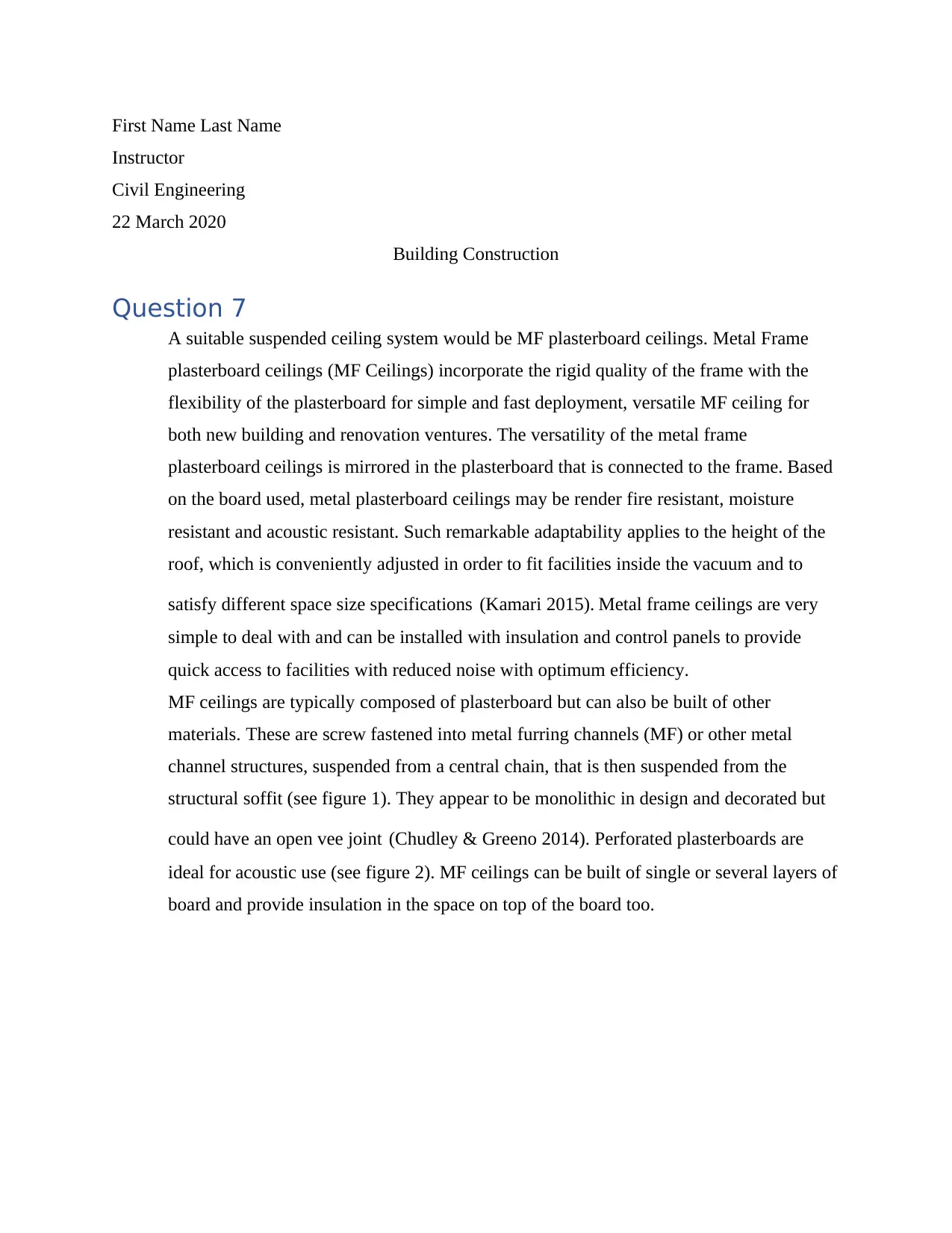
First Name Last Name
Instructor
Civil Engineering
22 March 2020
Building Construction
Question 7
A suitable suspended ceiling system would be MF plasterboard ceilings. Metal Frame
plasterboard ceilings (MF Ceilings) incorporate the rigid quality of the frame with the
flexibility of the plasterboard for simple and fast deployment, versatile MF ceiling for
both new building and renovation ventures. The versatility of the metal frame
plasterboard ceilings is mirrored in the plasterboard that is connected to the frame. Based
on the board used, metal plasterboard ceilings may be render fire resistant, moisture
resistant and acoustic resistant. Such remarkable adaptability applies to the height of the
roof, which is conveniently adjusted in order to fit facilities inside the vacuum and to
satisfy different space size specifications (Kamari 2015). Metal frame ceilings are very
simple to deal with and can be installed with insulation and control panels to provide
quick access to facilities with reduced noise with optimum efficiency.
MF ceilings are typically composed of plasterboard but can also be built of other
materials. These are screw fastened into metal furring channels (MF) or other metal
channel structures, suspended from a central chain, that is then suspended from the
structural soffit (see figure 1). They appear to be monolithic in design and decorated but
could have an open vee joint (Chudley & Greeno 2014). Perforated plasterboards are
ideal for acoustic use (see figure 2). MF ceilings can be built of single or several layers of
board and provide insulation in the space on top of the board too.
Instructor
Civil Engineering
22 March 2020
Building Construction
Question 7
A suitable suspended ceiling system would be MF plasterboard ceilings. Metal Frame
plasterboard ceilings (MF Ceilings) incorporate the rigid quality of the frame with the
flexibility of the plasterboard for simple and fast deployment, versatile MF ceiling for
both new building and renovation ventures. The versatility of the metal frame
plasterboard ceilings is mirrored in the plasterboard that is connected to the frame. Based
on the board used, metal plasterboard ceilings may be render fire resistant, moisture
resistant and acoustic resistant. Such remarkable adaptability applies to the height of the
roof, which is conveniently adjusted in order to fit facilities inside the vacuum and to
satisfy different space size specifications (Kamari 2015). Metal frame ceilings are very
simple to deal with and can be installed with insulation and control panels to provide
quick access to facilities with reduced noise with optimum efficiency.
MF ceilings are typically composed of plasterboard but can also be built of other
materials. These are screw fastened into metal furring channels (MF) or other metal
channel structures, suspended from a central chain, that is then suspended from the
structural soffit (see figure 1). They appear to be monolithic in design and decorated but
could have an open vee joint (Chudley & Greeno 2014). Perforated plasterboards are
ideal for acoustic use (see figure 2). MF ceilings can be built of single or several layers of
board and provide insulation in the space on top of the board too.
Secure Best Marks with AI Grader
Need help grading? Try our AI Grader for instant feedback on your assignments.
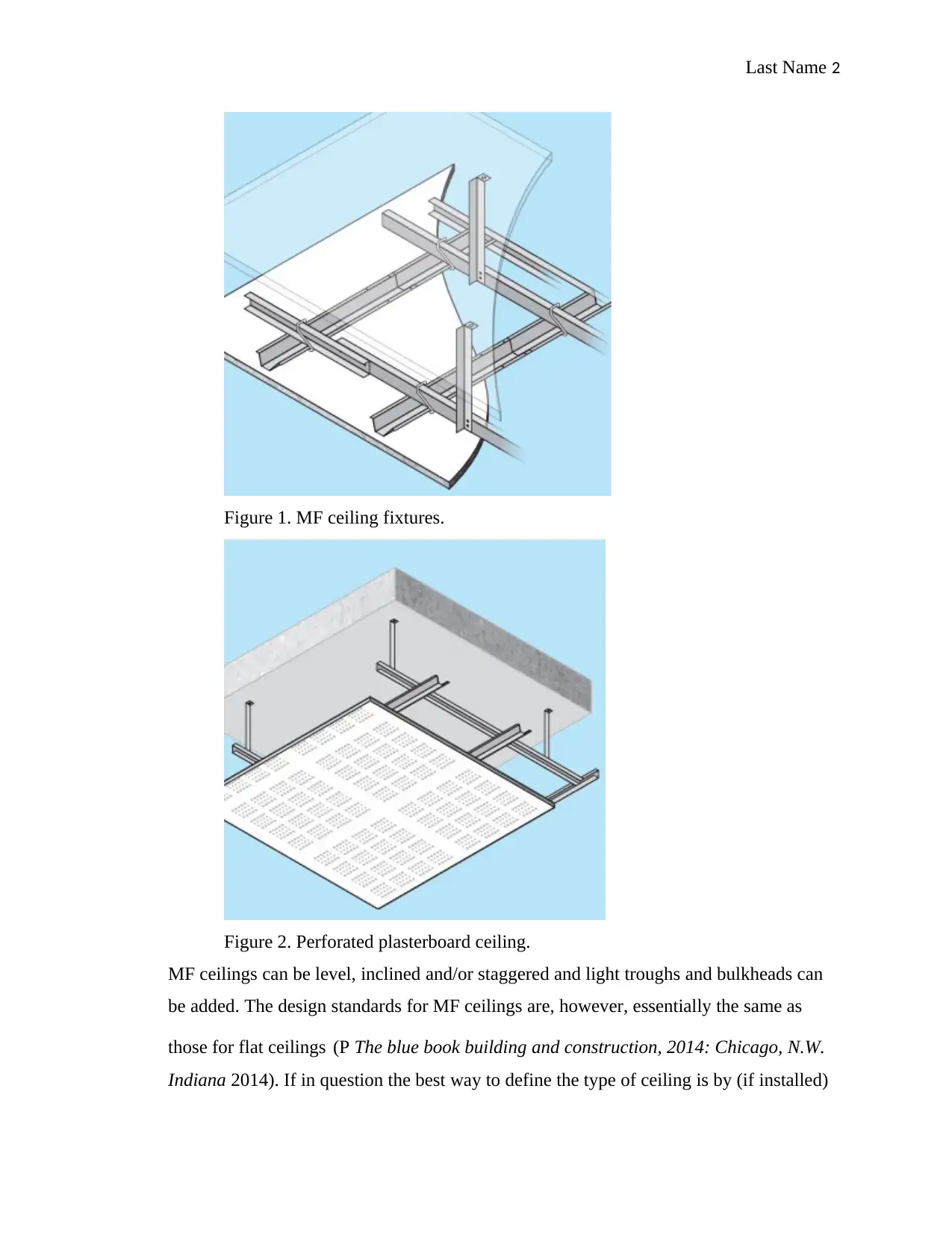
Last Name 2
Figure 1. MF ceiling fixtures.
Figure 2. Perforated plasterboard ceiling.
MF ceilings can be level, inclined and/or staggered and light troughs and bulkheads can
be added. The design standards for MF ceilings are, however, essentially the same as
those for flat ceilings (P The blue book building and construction, 2014: Chicago, N.W.
Indiana 2014). If in question the best way to define the type of ceiling is by (if installed)
Figure 1. MF ceiling fixtures.
Figure 2. Perforated plasterboard ceiling.
MF ceilings can be level, inclined and/or staggered and light troughs and bulkheads can
be added. The design standards for MF ceilings are, however, essentially the same as
those for flat ceilings (P The blue book building and construction, 2014: Chicago, N.W.
Indiana 2014). If in question the best way to define the type of ceiling is by (if installed)
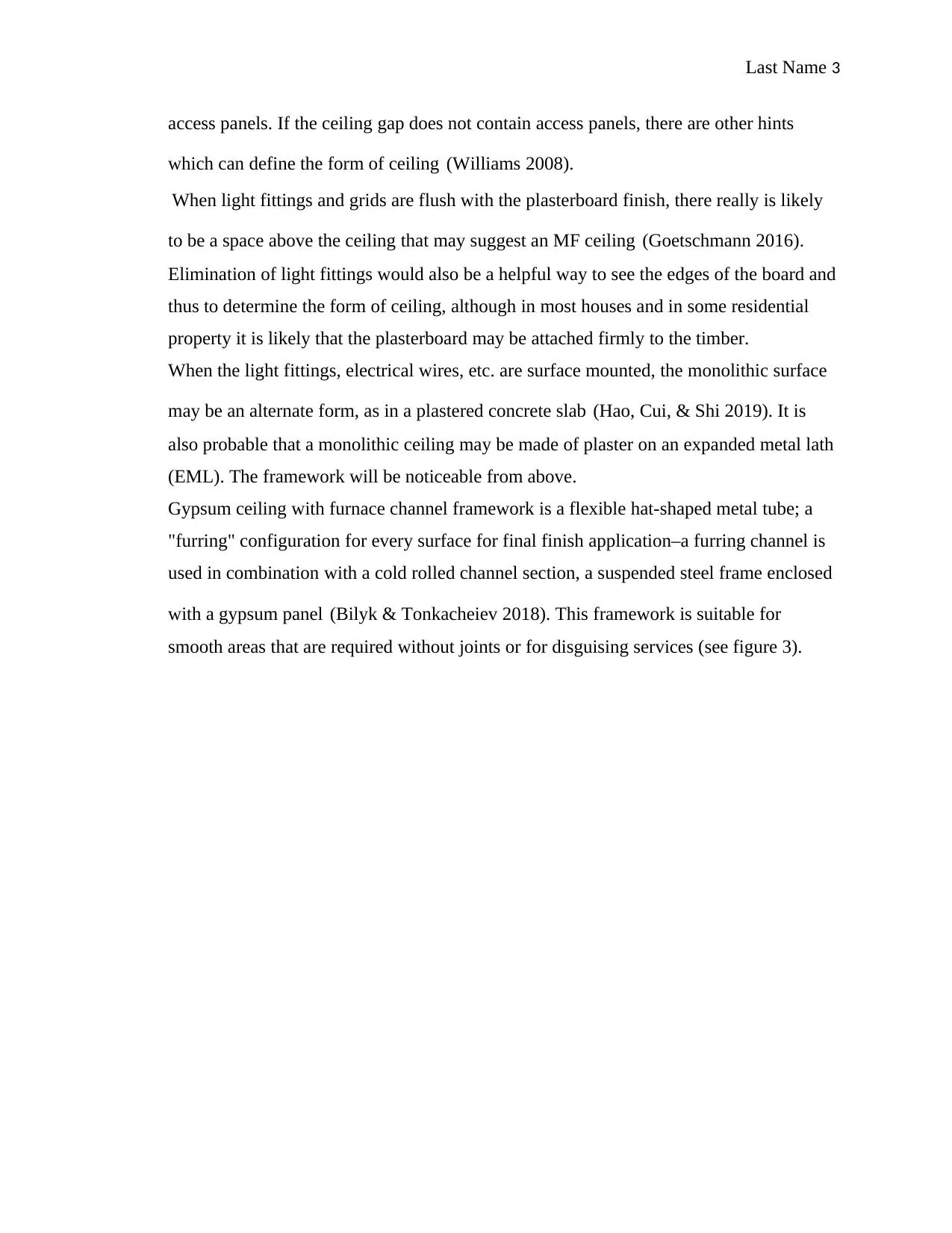
Last Name 3
access panels. If the ceiling gap does not contain access panels, there are other hints
which can define the form of ceiling (Williams 2008).
When light fittings and grids are flush with the plasterboard finish, there really is likely
to be a space above the ceiling that may suggest an MF ceiling (Goetschmann 2016).
Elimination of light fittings would also be a helpful way to see the edges of the board and
thus to determine the form of ceiling, although in most houses and in some residential
property it is likely that the plasterboard may be attached firmly to the timber.
When the light fittings, electrical wires, etc. are surface mounted, the monolithic surface
may be an alternate form, as in a plastered concrete slab (Hao, Cui, & Shi 2019). It is
also probable that a monolithic ceiling may be made of plaster on an expanded metal lath
(EML). The framework will be noticeable from above.
Gypsum ceiling with furnace channel framework is a flexible hat-shaped metal tube; a
"furring" configuration for every surface for final finish application–a furring channel is
used in combination with a cold rolled channel section, a suspended steel frame enclosed
with a gypsum panel (Bilyk & Tonkacheiev 2018). This framework is suitable for
smooth areas that are required without joints or for disguising services (see figure 3).
access panels. If the ceiling gap does not contain access panels, there are other hints
which can define the form of ceiling (Williams 2008).
When light fittings and grids are flush with the plasterboard finish, there really is likely
to be a space above the ceiling that may suggest an MF ceiling (Goetschmann 2016).
Elimination of light fittings would also be a helpful way to see the edges of the board and
thus to determine the form of ceiling, although in most houses and in some residential
property it is likely that the plasterboard may be attached firmly to the timber.
When the light fittings, electrical wires, etc. are surface mounted, the monolithic surface
may be an alternate form, as in a plastered concrete slab (Hao, Cui, & Shi 2019). It is
also probable that a monolithic ceiling may be made of plaster on an expanded metal lath
(EML). The framework will be noticeable from above.
Gypsum ceiling with furnace channel framework is a flexible hat-shaped metal tube; a
"furring" configuration for every surface for final finish application–a furring channel is
used in combination with a cold rolled channel section, a suspended steel frame enclosed
with a gypsum panel (Bilyk & Tonkacheiev 2018). This framework is suitable for
smooth areas that are required without joints or for disguising services (see figure 3).
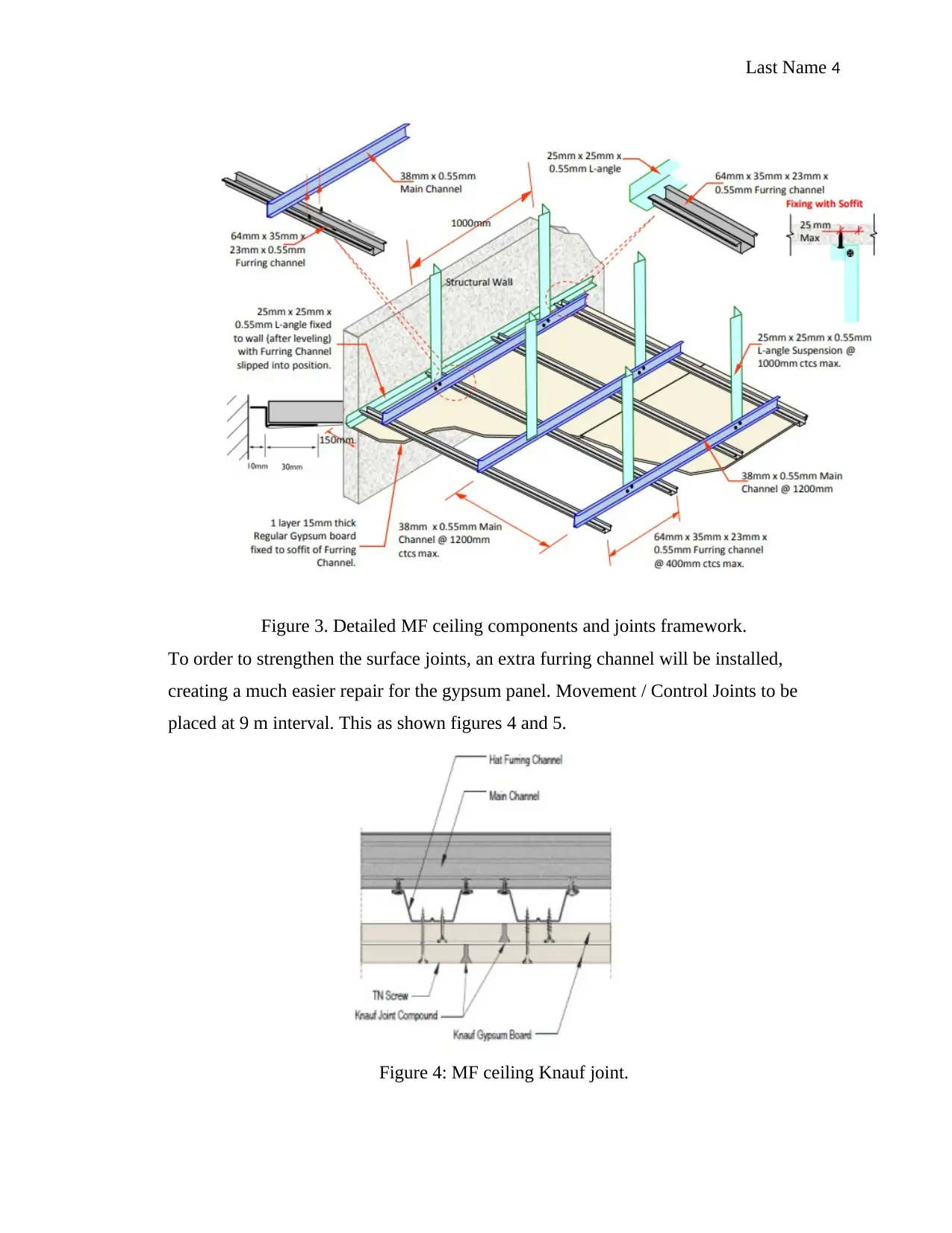
Last Name 4
Figure 3. Detailed MF ceiling components and joints framework.
To order to strengthen the surface joints, an extra furring channel will be installed,
creating a much easier repair for the gypsum panel. Movement / Control Joints to be
placed at 9 m interval. This as shown figures 4 and 5.
Figure 4: MF ceiling Knauf joint.
Figure 3. Detailed MF ceiling components and joints framework.
To order to strengthen the surface joints, an extra furring channel will be installed,
creating a much easier repair for the gypsum panel. Movement / Control Joints to be
placed at 9 m interval. This as shown figures 4 and 5.
Figure 4: MF ceiling Knauf joint.
Secure Best Marks with AI Grader
Need help grading? Try our AI Grader for instant feedback on your assignments.
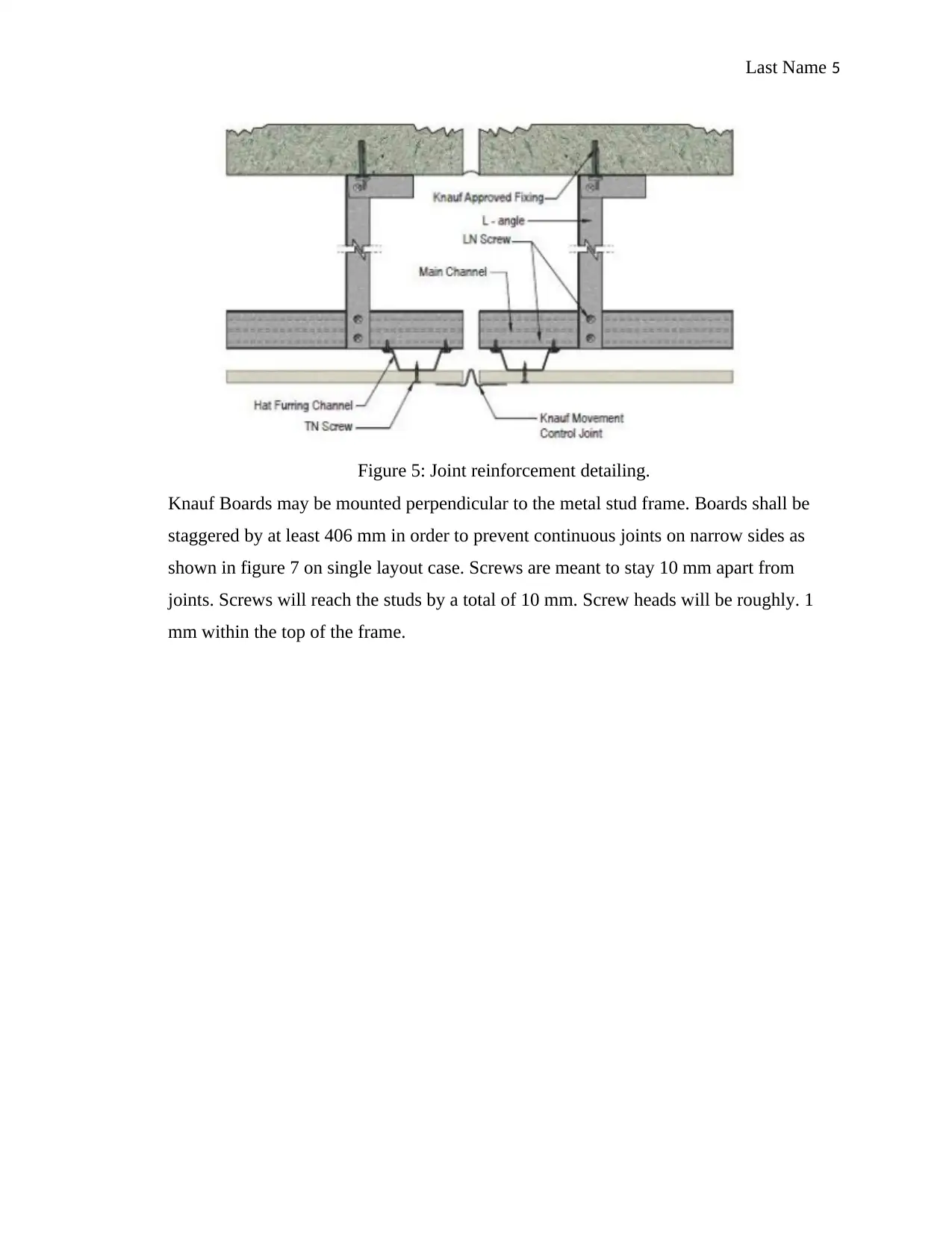
Last Name 5
Figure 5: Joint reinforcement detailing.
Knauf Boards may be mounted perpendicular to the metal stud frame. Boards shall be
staggered by at least 406 mm in order to prevent continuous joints on narrow sides as
shown in figure 7 on single layout case. Screws are meant to stay 10 mm apart from
joints. Screws will reach the studs by a total of 10 mm. Screw heads will be roughly. 1
mm within the top of the frame.
Figure 5: Joint reinforcement detailing.
Knauf Boards may be mounted perpendicular to the metal stud frame. Boards shall be
staggered by at least 406 mm in order to prevent continuous joints on narrow sides as
shown in figure 7 on single layout case. Screws are meant to stay 10 mm apart from
joints. Screws will reach the studs by a total of 10 mm. Screw heads will be roughly. 1
mm within the top of the frame.
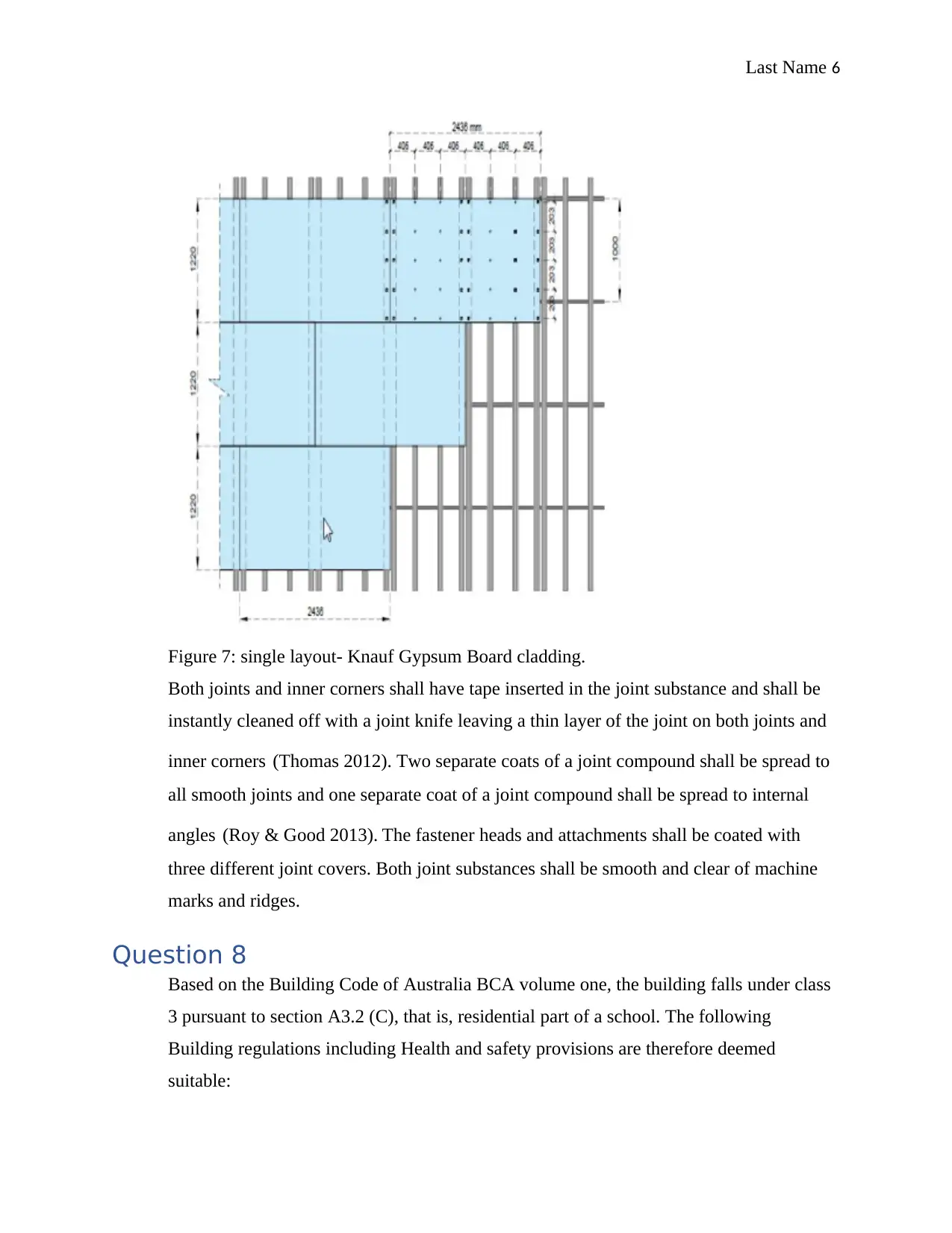
Last Name 6
Figure 7: single layout- Knauf Gypsum Board cladding.
Both joints and inner corners shall have tape inserted in the joint substance and shall be
instantly cleaned off with a joint knife leaving a thin layer of the joint on both joints and
inner corners (Thomas 2012). Two separate coats of a joint compound shall be spread to
all smooth joints and one separate coat of a joint compound shall be spread to internal
angles (Roy & Good 2013). The fastener heads and attachments shall be coated with
three different joint covers. Both joint substances shall be smooth and clear of machine
marks and ridges.
Question 8
Based on the Building Code of Australia BCA volume one, the building falls under class
3 pursuant to section A3.2 (C), that is, residential part of a school. The following
Building regulations including Health and safety provisions are therefore deemed
suitable:
Figure 7: single layout- Knauf Gypsum Board cladding.
Both joints and inner corners shall have tape inserted in the joint substance and shall be
instantly cleaned off with a joint knife leaving a thin layer of the joint on both joints and
inner corners (Thomas 2012). Two separate coats of a joint compound shall be spread to
all smooth joints and one separate coat of a joint compound shall be spread to internal
angles (Roy & Good 2013). The fastener heads and attachments shall be coated with
three different joint covers. Both joint substances shall be smooth and clear of machine
marks and ridges.
Question 8
Based on the Building Code of Australia BCA volume one, the building falls under class
3 pursuant to section A3.2 (C), that is, residential part of a school. The following
Building regulations including Health and safety provisions are therefore deemed
suitable:
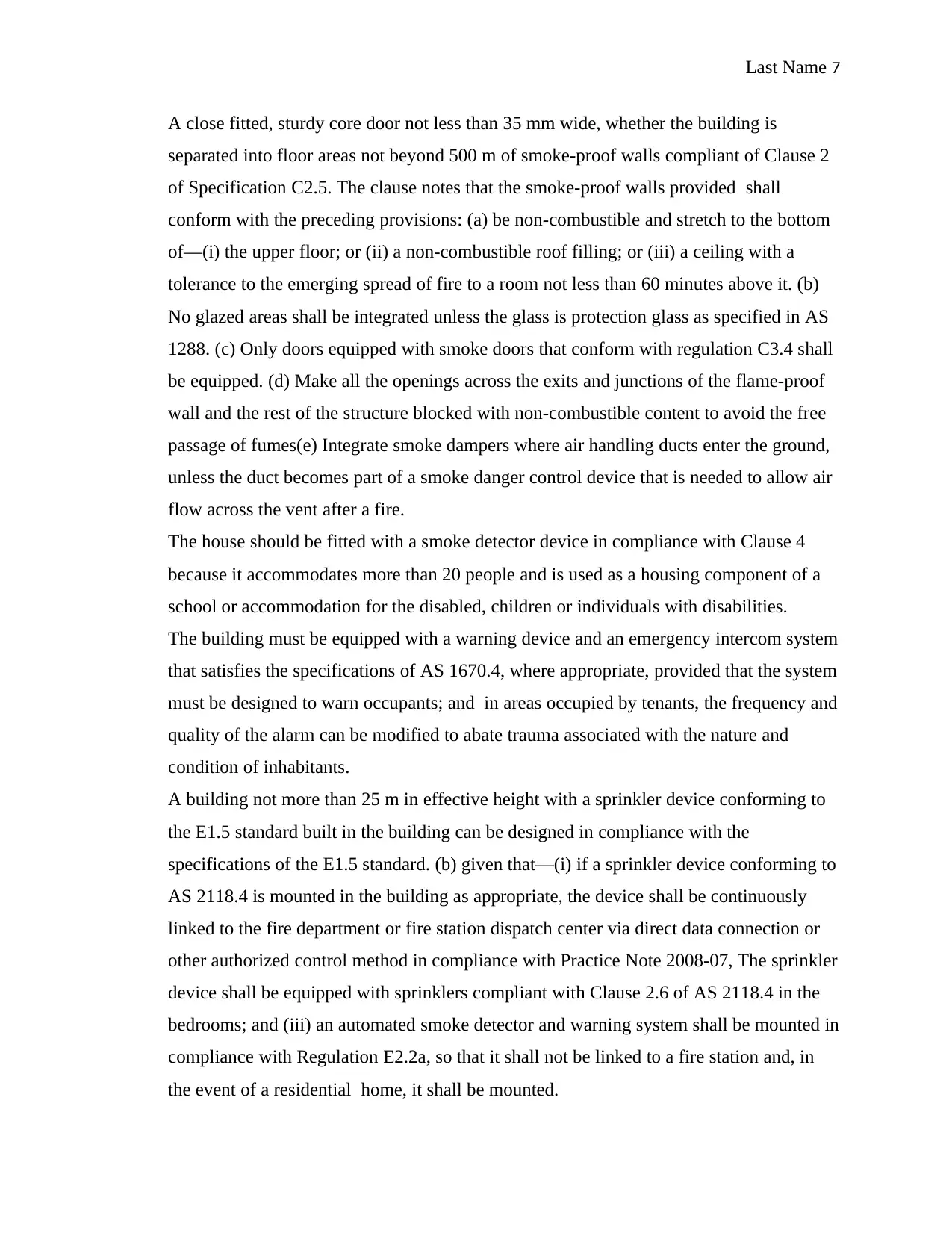
Last Name 7
A close fitted, sturdy core door not less than 35 mm wide, whether the building is
separated into floor areas not beyond 500 m of smoke-proof walls compliant of Clause 2
of Specification C2.5. The clause notes that the smoke-proof walls provided shall
conform with the preceding provisions: (a) be non-combustible and stretch to the bottom
of—(i) the upper floor; or (ii) a non-combustible roof filling; or (iii) a ceiling with a
tolerance to the emerging spread of fire to a room not less than 60 minutes above it. (b)
No glazed areas shall be integrated unless the glass is protection glass as specified in AS
1288. (c) Only doors equipped with smoke doors that conform with regulation C3.4 shall
be equipped. (d) Make all the openings across the exits and junctions of the flame-proof
wall and the rest of the structure blocked with non-combustible content to avoid the free
passage of fumes(e) Integrate smoke dampers where air handling ducts enter the ground,
unless the duct becomes part of a smoke danger control device that is needed to allow air
flow across the vent after a fire.
The house should be fitted with a smoke detector device in compliance with Clause 4
because it accommodates more than 20 people and is used as a housing component of a
school or accommodation for the disabled, children or individuals with disabilities.
The building must be equipped with a warning device and an emergency intercom system
that satisfies the specifications of AS 1670.4, where appropriate, provided that the system
must be designed to warn occupants; and in areas occupied by tenants, the frequency and
quality of the alarm can be modified to abate trauma associated with the nature and
condition of inhabitants.
A building not more than 25 m in effective height with a sprinkler device conforming to
the E1.5 standard built in the building can be designed in compliance with the
specifications of the E1.5 standard. (b) given that—(i) if a sprinkler device conforming to
AS 2118.4 is mounted in the building as appropriate, the device shall be continuously
linked to the fire department or fire station dispatch center via direct data connection or
other authorized control method in compliance with Practice Note 2008-07, The sprinkler
device shall be equipped with sprinklers compliant with Clause 2.6 of AS 2118.4 in the
bedrooms; and (iii) an automated smoke detector and warning system shall be mounted in
compliance with Regulation E2.2a, so that it shall not be linked to a fire station and, in
the event of a residential home, it shall be mounted.
A close fitted, sturdy core door not less than 35 mm wide, whether the building is
separated into floor areas not beyond 500 m of smoke-proof walls compliant of Clause 2
of Specification C2.5. The clause notes that the smoke-proof walls provided shall
conform with the preceding provisions: (a) be non-combustible and stretch to the bottom
of—(i) the upper floor; or (ii) a non-combustible roof filling; or (iii) a ceiling with a
tolerance to the emerging spread of fire to a room not less than 60 minutes above it. (b)
No glazed areas shall be integrated unless the glass is protection glass as specified in AS
1288. (c) Only doors equipped with smoke doors that conform with regulation C3.4 shall
be equipped. (d) Make all the openings across the exits and junctions of the flame-proof
wall and the rest of the structure blocked with non-combustible content to avoid the free
passage of fumes(e) Integrate smoke dampers where air handling ducts enter the ground,
unless the duct becomes part of a smoke danger control device that is needed to allow air
flow across the vent after a fire.
The house should be fitted with a smoke detector device in compliance with Clause 4
because it accommodates more than 20 people and is used as a housing component of a
school or accommodation for the disabled, children or individuals with disabilities.
The building must be equipped with a warning device and an emergency intercom system
that satisfies the specifications of AS 1670.4, where appropriate, provided that the system
must be designed to warn occupants; and in areas occupied by tenants, the frequency and
quality of the alarm can be modified to abate trauma associated with the nature and
condition of inhabitants.
A building not more than 25 m in effective height with a sprinkler device conforming to
the E1.5 standard built in the building can be designed in compliance with the
specifications of the E1.5 standard. (b) given that—(i) if a sprinkler device conforming to
AS 2118.4 is mounted in the building as appropriate, the device shall be continuously
linked to the fire department or fire station dispatch center via direct data connection or
other authorized control method in compliance with Practice Note 2008-07, The sprinkler
device shall be equipped with sprinklers compliant with Clause 2.6 of AS 2118.4 in the
bedrooms; and (iii) an automated smoke detector and warning system shall be mounted in
compliance with Regulation E2.2a, so that it shall not be linked to a fire station and, in
the event of a residential home, it shall be mounted.
Paraphrase This Document
Need a fresh take? Get an instant paraphrase of this document with our AI Paraphraser
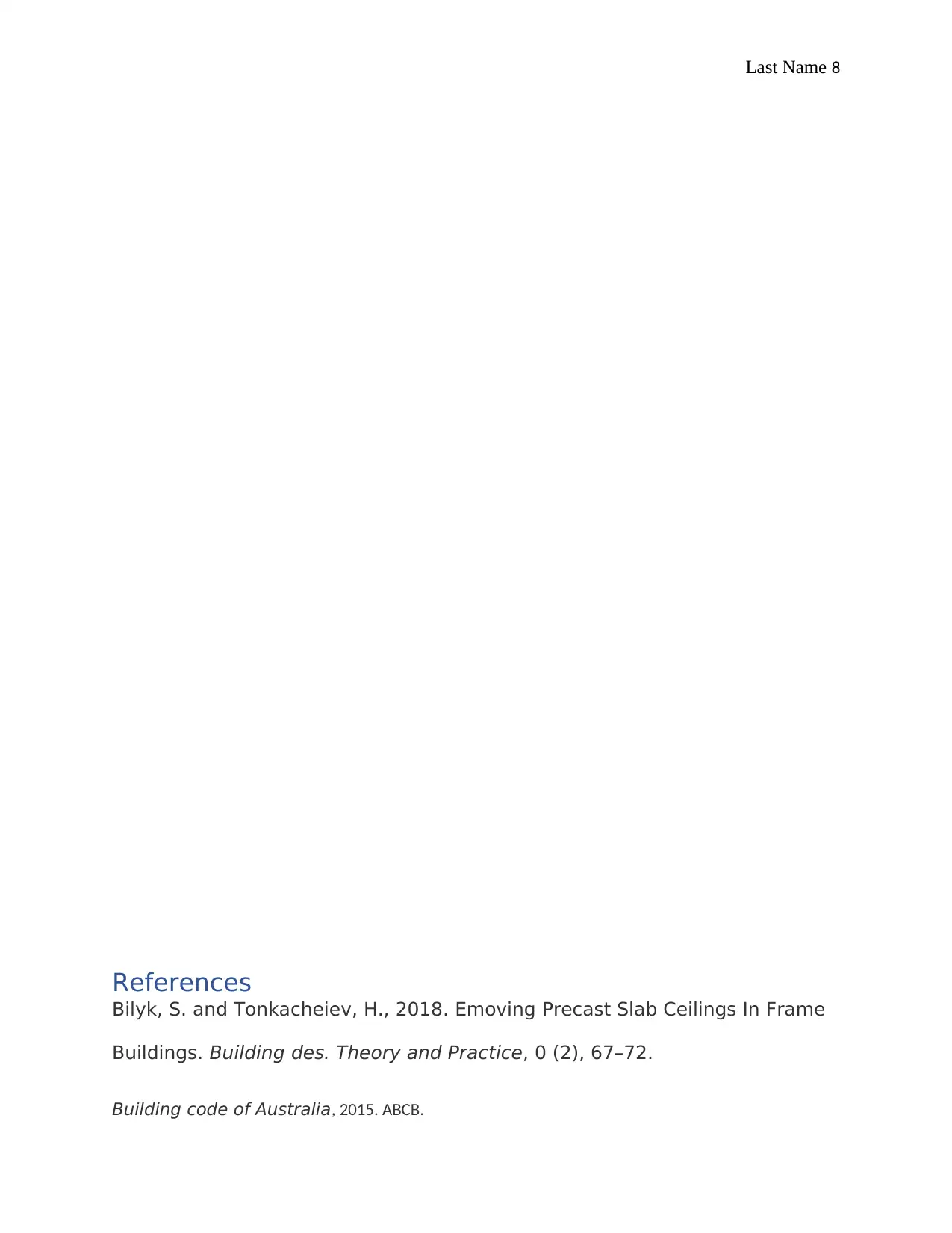
Last Name 8
References
Bilyk, S. and Tonkacheiev, H., 2018. Emoving Precast Slab Ceilings In Frame
Buildings. Building des. Theory and Practice, 0 (2), 67–72.
Building code of Australia, 2015. ABCB.
References
Bilyk, S. and Tonkacheiev, H., 2018. Emoving Precast Slab Ceilings In Frame
Buildings. Building des. Theory and Practice, 0 (2), 67–72.
Building code of Australia, 2015. ABCB.
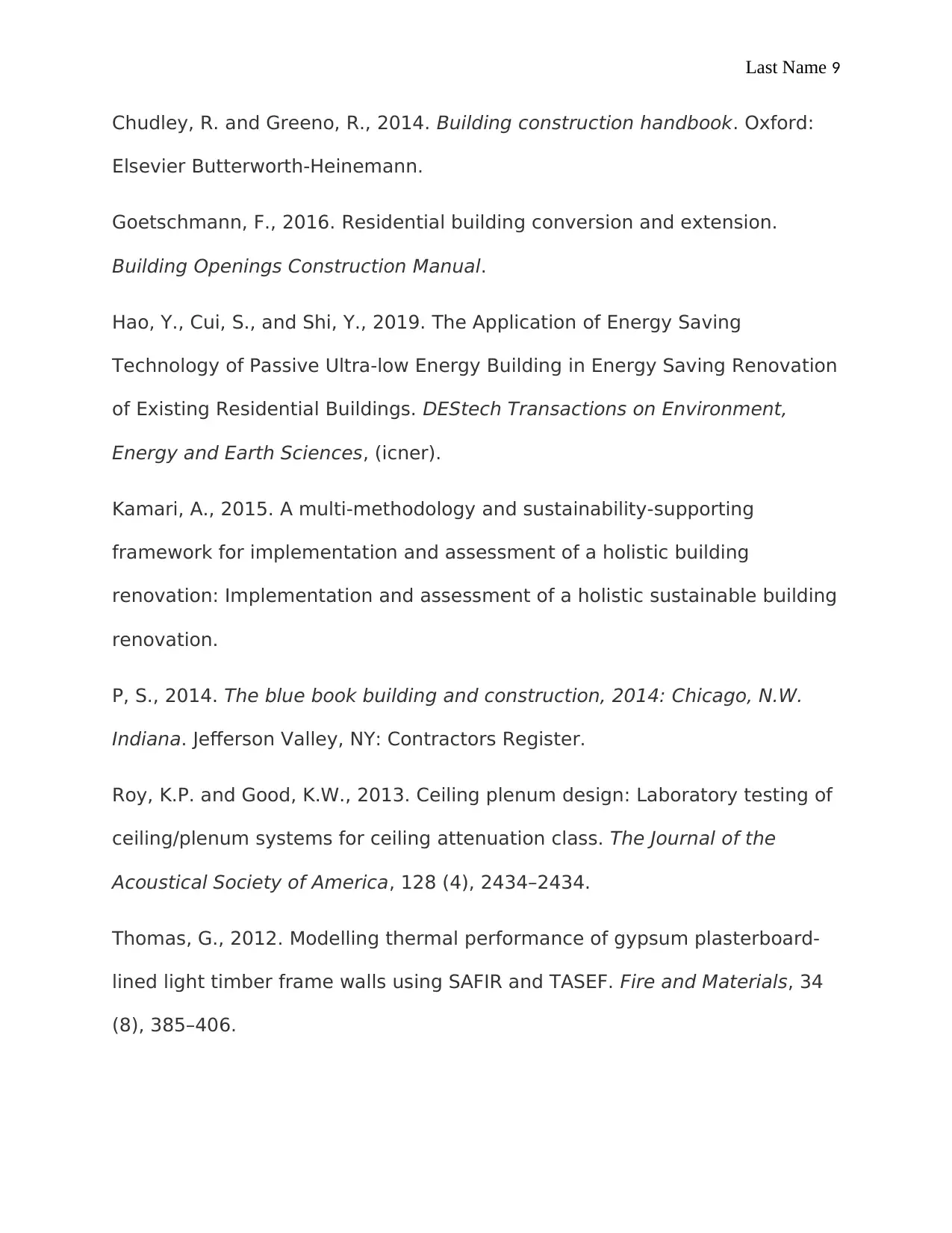
Last Name 9
Chudley, R. and Greeno, R., 2014. Building construction handbook. Oxford:
Elsevier Butterworth-Heinemann.
Goetschmann, F., 2016. Residential building conversion and extension.
Building Openings Construction Manual.
Hao, Y., Cui, S., and Shi, Y., 2019. The Application of Energy Saving
Technology of Passive Ultra-low Energy Building in Energy Saving Renovation
of Existing Residential Buildings. DEStech Transactions on Environment,
Energy and Earth Sciences, (icner).
Kamari, A., 2015. A multi-methodology and sustainability-supporting
framework for implementation and assessment of a holistic building
renovation: Implementation and assessment of a holistic sustainable building
renovation.
P, S., 2014. The blue book building and construction, 2014: Chicago, N.W.
Indiana. Jefferson Valley, NY: Contractors Register.
Roy, K.P. and Good, K.W., 2013. Ceiling plenum design: Laboratory testing of
ceiling/plenum systems for ceiling attenuation class. The Journal of the
Acoustical Society of America, 128 (4), 2434–2434.
Thomas, G., 2012. Modelling thermal performance of gypsum plasterboard-
lined light timber frame walls using SAFIR and TASEF. Fire and Materials, 34
(8), 385–406.
Chudley, R. and Greeno, R., 2014. Building construction handbook. Oxford:
Elsevier Butterworth-Heinemann.
Goetschmann, F., 2016. Residential building conversion and extension.
Building Openings Construction Manual.
Hao, Y., Cui, S., and Shi, Y., 2019. The Application of Energy Saving
Technology of Passive Ultra-low Energy Building in Energy Saving Renovation
of Existing Residential Buildings. DEStech Transactions on Environment,
Energy and Earth Sciences, (icner).
Kamari, A., 2015. A multi-methodology and sustainability-supporting
framework for implementation and assessment of a holistic building
renovation: Implementation and assessment of a holistic sustainable building
renovation.
P, S., 2014. The blue book building and construction, 2014: Chicago, N.W.
Indiana. Jefferson Valley, NY: Contractors Register.
Roy, K.P. and Good, K.W., 2013. Ceiling plenum design: Laboratory testing of
ceiling/plenum systems for ceiling attenuation class. The Journal of the
Acoustical Society of America, 128 (4), 2434–2434.
Thomas, G., 2012. Modelling thermal performance of gypsum plasterboard-
lined light timber frame walls using SAFIR and TASEF. Fire and Materials, 34
(8), 385–406.
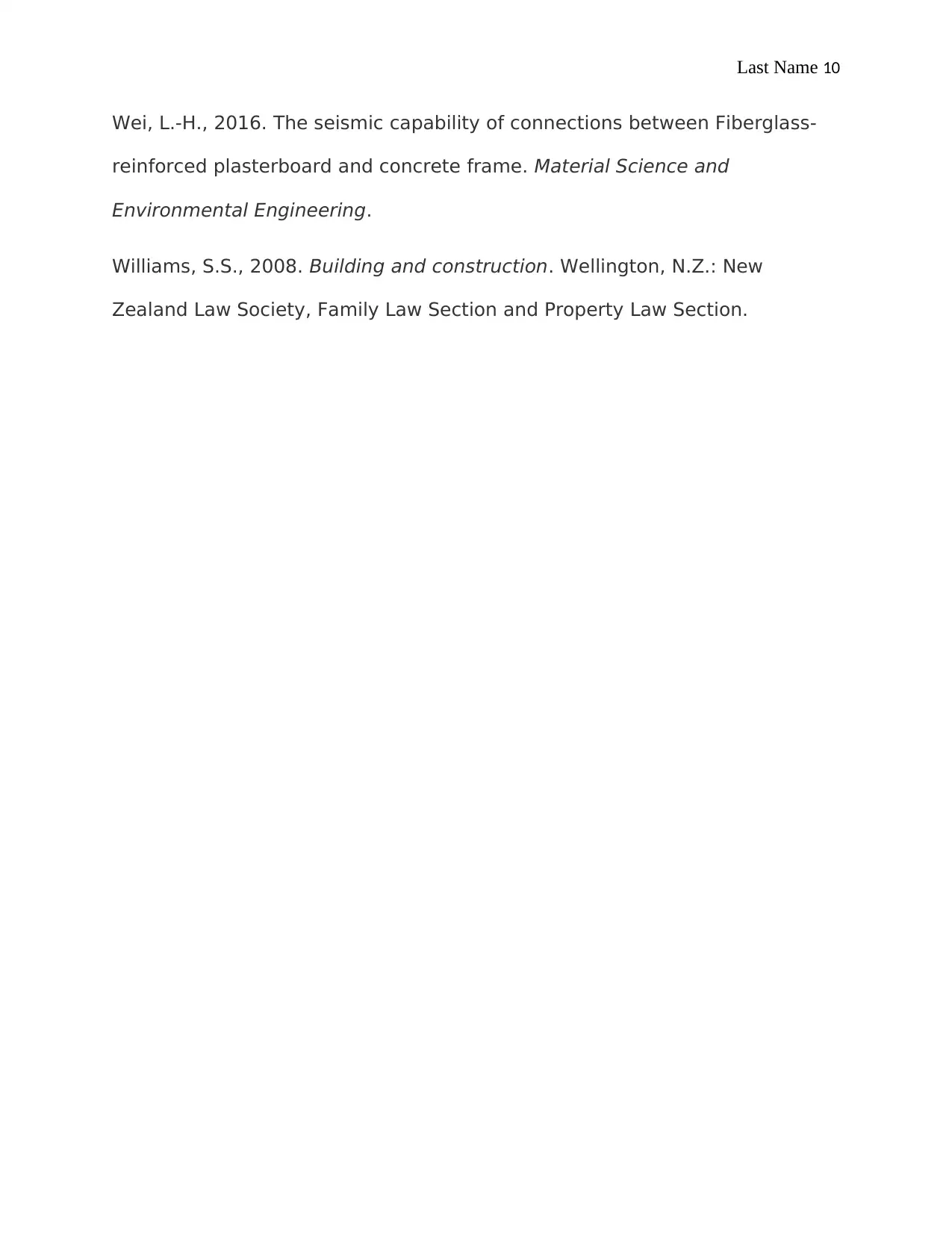
Last Name 10
Wei, L.-H., 2016. The seismic capability of connections between Fiberglass-
reinforced plasterboard and concrete frame. Material Science and
Environmental Engineering.
Williams, S.S., 2008. Building and construction. Wellington, N.Z.: New
Zealand Law Society, Family Law Section and Property Law Section.
Wei, L.-H., 2016. The seismic capability of connections between Fiberglass-
reinforced plasterboard and concrete frame. Material Science and
Environmental Engineering.
Williams, S.S., 2008. Building and construction. Wellington, N.Z.: New
Zealand Law Society, Family Law Section and Property Law Section.
1 out of 10
Your All-in-One AI-Powered Toolkit for Academic Success.
+13062052269
info@desklib.com
Available 24*7 on WhatsApp / Email
![[object Object]](/_next/static/media/star-bottom.7253800d.svg)
Unlock your academic potential
© 2024 | Zucol Services PVT LTD | All rights reserved.